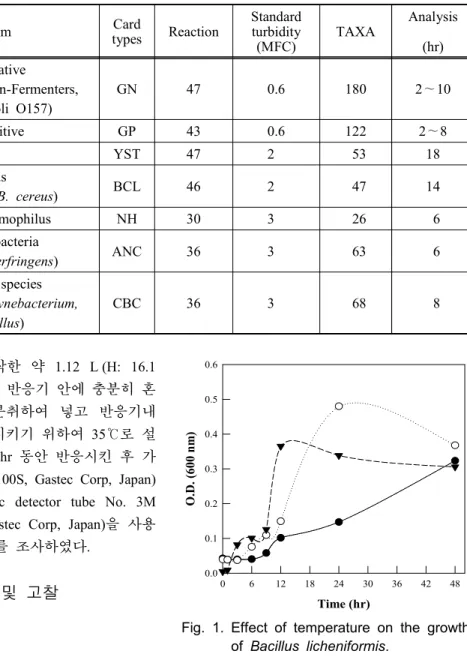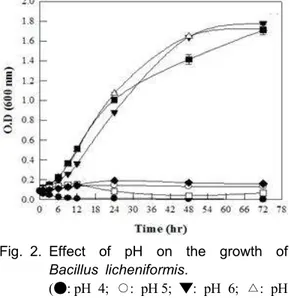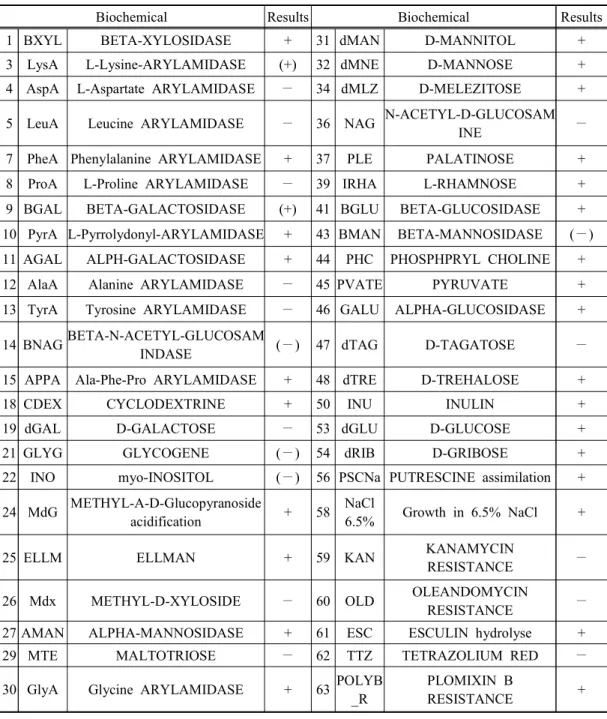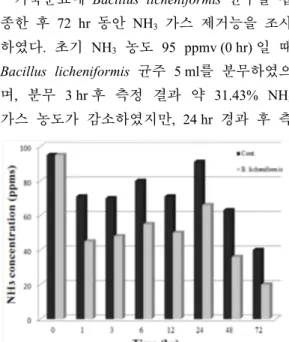*Corresponding author : Sung-Back Cho, National Institute of Animal Science, R.D.A. Iseo-myeon 55365, Korea, Tel : +82-63-238-7412, E-mail : csb652@korea.kr
2015년 7월 8일 투고, 2015년 8월 3일 심사완료, 2015년 8월 5일 게재확정
Vitek 2 Compact System을 이용한 Bacillus licheniformis의 동정 및 NH3 저감효과
임정수⋅한덕우⋅이상룡⋅황옥화⋅곽정훈⋅조성백*
농촌진흥청 국립축산과학원
A Bacterial Strain Identified as Bacillus licheniformis using Vitek 2 Effectively Reduced NH3 Emission from Swine Manure
Joung-Soo Lim, Deug-Woo Han, Sang-Ryong Lee, Ok-Hwa Hwang, Jung-Hoon Kwag, Sung-Back Cho*
National Institute of Animal Science, R.D.A., Wanju-Gun 55365, Korea
ABSTRACT
An attempt to produce more pigs in limited spaces inevitably generalized concentrated feeding operation (CFO). As concentrated pig production practice expanded, concerns on environmental issues grow concurrently. Since odor is the concerned most among those, we attempted to develop means to tackle odor emission from livestock operations. Previously, we excavated few micro- organisms from pig manure and, one of them, Bacillus licheniformis was particularly useful to handle odor problem. In this study, we conducted our investigation to further characterize Bacillus licheniformis. Strain identification was conducted using Vitek 2 compact, and the optimal temperature and pH conditions to growth B. licheniformis were searched for by analyzing turbidity on O.D 600 nm.
Results of this study can be summarized as these, (1) it was re-verified that the bacterial strain that purified from pig manure was, in fact, Bacillus licheniformis, (2) the bacterial growth was highest when the temperature was kept at 30℃, also (3) growth rate was dependent on media pH as it was high at neutral (6, 7 and 8) but dropped when it was diverged from neutral (4, 5, 9 and 10), and (4) regarding ammonia removal efficiency, B. licheniformis recorded 64% effectiveness after 48 h incubation and reached its highest (80%) at 72 h.
(Key words : Livestock, Manure, pH, Microorganism, Bacillus licheniformis)
서 론
축산업에 있어서 가축분뇨에서 발생되는 악취는 지역 주민들에게 불쾌감을 초래하며
이로 인해 많은 민원이 발생된다. 이러한 악
취는 분뇨가 다양한 환경조건으로부터 혐기
적으로 분해되는 과정에서 대기 중으로 노출
될 때 휘발성 물질 및 그 중간생성물이 대기
로 방출되는 화합물이다. 이러한 화합물에서 발생되는 불쾌한 악취는 작업자뿐만 아니라 가축의 심리, 건강 및 생산성에 영향을 미친 다 (Tamminga, 1992). 또한, 급이 사료로부터 발생되는 악취물질의 경우 가축으로부터 질 소의 50% 이상이 요소로 배설된다. 따라서, 분뇨 내 질소원을 감소시키기 위해서는 urease 효소를 억제해야 한다 (Mackie et al., 1998).
이처럼 분뇨는 악취의 근원이며 (Lowe, 1995), 이러한 분뇨 내 질소의 배설량을 감소시키기 위해서는 단백질 소화율을 개선 할 수 있는 효소제나 미생물제제, 효모제 및 생균제를 이용하거나 (Min et al., 1992; Park et al., 1994), 사료 내 단백질 수준을 낮추고 합성아 미노산을 급여함으로써 질소 배설량을 감소 시켜야 한다 (Sutton et al., 1999; Shriver et al., 2003). 이외에도 급이 사료에 대한 많은 연구가 이루어지고 있으며, 특히, 보조 사료 로서의 생균제 급여는 축산업뿐만 아니라 환 경개선에도 많은 영향을 미치고 있다.
또한, 생균제 급여에 따른 가축의 장내 세 균 및 환경 개선으로 암모니아 발생량을 저 감하고자 하는 연구들이 다양하게 진행되어 왔으며 생균제 급여 및 살포에 따른 암모니 아 저감효과에 관한 연구는 꾸준히 진행되고 있다. Wang 등 (2009)은 비육돈을 대상으로 한 Bacillus subtilis, Bacillus licheniformis, aluminum silicate 및 유장가루가 함유된 제제 를 사료에 첨가한 결과, 처리구의 슬러리에 서 발생된 암모니아가 대조구에 비해 낮았다 고 보고하였다. 또한, Bacillus subtilis 배양액 을 육계사료에 1~2% 첨가할 경우 약 36~72
%의 암모니아 가스가 감소되었으며 (Santoso et al., 1999), 유산균과 Bacillus 제제가 함유 된 생균제를 급여한 결과 계분과 바닥에서의 암모니아 가스가 감소하였다고 보고하였다 (Chiang and Hsieh, 1995).
이외에도, Bacillus genus에는 다양한 종 (species)이 있고 이 중 대부분이 비병원성으
로 배양이 간단하고 단백질이나 대사산물을 잘 분비하며 각종 효소, 항생제 (Kleinkauf and Dohren, 1983), 살충제 (Bella et al., 1985) 및 아미노산 (Priest, 1989) 등 다양한 발효산물을 생산하는 균주로 사용되며 (Arbige et al., 1989), 다양한 세포외 섬유질 분해효소를 생산한다 (Roboson and Chambliss, 1989). 또한, lichenysin, lichenicidine 등은 peptide와 lipopeptide antibiotics 및 bacitracins은 항세균 또는 항진 균 특성을 가지고 있다 (Abriouel et al., 2011;
Lee and Kim, 2011; Dischinger et al., 2009;
Yang and Chang, 2007). 특히, Bacillus licheniformis는 미국 식품의약국 (FDA)에 의 해 인체 및 환경에 무해한 미생물로 인정받 고 있으며, 다양한 종류의 계면활성제나 항 생물질을 생산하여 경쟁관계에 있는 주위 균 들의 증식을 억제하고, 일부는 biogenic amine 을 분해하는 능력을 가지고 있다고 알려져 있다 (Asaka and Shoda, 1996; Berger et al., 1996; Seddon et al., 1996; Grangemard et al., 2001; Yang and Chang, 2007). 이처럼, Bacillus licheniformis는 열에 대한 안전성과 단백질 가수분해 저항성을 지니고 있으며, 안전하고 환경 친화적인 유익한 미생물이라 할 수 있다. 따라서 본 연구는 안정적이고 효율적인 축산 냄새저감을 위한 균주를 이용 하여 돈분뇨 내에서 발생되는 NH
3가스 저감 효과를 평가하여, 냄새저감 미생물제제를 개 발하는데 있어 기초자료로 활용하고자 한다.
재료 및 방법
1. 균주의 분리 및 배지 조성
본 실험에 사용된 NH
3저감 미생물은 국
립축산과학원 시험돈사의 돈분뇨를 분리원으
로하여 균주를 순수 분리하였다. 돈분뇨 10 g
을 증류수 90 ml에 혼합하여 120 rpm에서 12
hr 동안 현탁 한 후 상징액을 취하여 사용하
였으며, 돈분균주의 분리동정을 위해 NA (Nutrient Agar (NA, Difco Co.) 배지에 도말한 후 35℃에서 incubator에서 배양하여 colony를 확인하였으며, 형성된 colony의 색과 모양을 고려하여 미생물을 선별 하였다. 이렇게 선 별된 균주를 Tryptic soy broth (TSB, Difco Co.) 배지에 접종하여 35℃로 설정된 Shaking incubator(VS-8480SR, Vision Scientific co., ltd) 를 이용하여 150 rpm으로 24 hr 동안 배양하 여 실험의 접종원으로 사용하였으며, 균주는 48 hr 간격으로 계대배양 하여 4℃에서 보관 하였다.
2. 균주의 성장 특성
(1) 균주의 성장 시험
배양중인 배지에서 초기 12 hr까지는 3 hr 간격으로 측정하였으며, 24 ∼72 hr 동안 4 hr 간격으로 배양액 4 ml를 취하여 UV-VIS Spectrophotometer (Shimadzu, UV-2700, Japan) 을 사용하여 O.D. (Optical Density) 600 nm에 서 균 탁도를 측정하였다.
(2) 온도 변화에 따른 영향
250 ml 삼각플라스크에 Tryptic soy broth 배지 90 ml를 넣고 전 배양된 Bacillus licheni- formis 균주를 10% (v/v)가 되도록 접종한 후, 다양한 온도 조건 25 ℃, 30℃ 및 35℃로 설 정된 각각의 shaking incubator를 이용하여 150 rpm으로 진탕배양하면서 균주의 배양온 도에 따른 균 성장 능을 측정하였다.
(3) pH의 변화에 따른 영향
pH 변화에 따른 균 성장능을 확인하기 위 하여 각각의 pH buffer (Citric acid buffer, Phosphate buffer, Glycine, NaOH buffer)를 제 조하여 250 ml 삼각플라스크에 90 ml의 Tryptic soy broth 배지를 넣고 전 배양된 Bacillus licheniformis 균주를 10% (v/v)가 되도록 접종
한 후, pH 4~10에서의 균 성장 능을 조사하 였다. 배지의 pH는 0.1 N-HCl과 0.1 N-NaOH 를 이용하여 조절하였다.
3. 균주 동정
순수 분리가 된 균의 분자생물학적 동정을 위해서 plate에서 배양한 균체를 Macrogen Inc. (Korea)에 의뢰하여 16S rDNA sequencing 방법에 의거하여 동정하였다. 이후 염기서열 을 조합하여 NCBI (The National Center for Biotechnology Information, http://www.ncbi.nlm.
nih.gov/)에서 제공하는 Advanced Blast search (Altschul et al., 1997)를 이용하여 Genebank (NCBI, Bethesda, MD, USA)의 염기서열과 비 교하였다.
4. Vitek 2 compact system을 이용한 방법
Vitek 2 compact (bioMérieux, Inc., France)에 의한 균 동정은 순수 배양된 Bacillus licheni- formis 균 집락을 5×1 cm 튜브에 0.45% NaCl 이 함유된 생리식염수 3 ml를 분취한 후 Vitek densichek (bioMérieux, Inc., France)를 이 용하여 탁도 2 McFarland로 현탁하여 사용하 였다. 현탁된 균액은 Vitek 전용 rack에 고정 한 후 Bacillus licheniformis 동정을 위해 BCL card (bioMérieux, Inc., France)에 일정량을 분 취하여 사용하였다. 이후 일련의 과정은 제조 사에서 제공한 실험방법에 따라 시행하였으며, 반응이 끝나면 Vitek 2의 Advanced Expert System (AES) software에 의해 판독 결과를 볼 수 있다.
5. NH
3저감
본 실험에서는 돈 분뇨를 6:4 (wt/wt)의 비
율로 충분히 혼합하여 사용하였다. 또한 돈
분뇨에서 발생되는 NH
3가스 농도를 조사하
Time (hr)
0 6 12 18 24 30 36 42 48
O.D. (600 nm)
0.0 0.1 0.2 0.3 0.4 0.5 0.6
Fig. 1. Effect of temperature on the growth of Bacillus licheniformis.
( ●: 25℃ ; ○: 30℃ ; ▼: 35℃) Table 1. List of the cards in Vitek 2 compact
Organism Card
types Reaction
Standard turbidity (MFC)
TAXA
Analysis (hr) Gram-negative
(Fermenters & Non-Fermenters, Escherichia coli O157)
GN 47 0.6 180 2∼10
Gram-positive GP 43 0.6 122 2∼8
Yeast YST 47 2 53 18
Bacillus
(B. anthracis, B. cereus) BCL 46 2 47 14
Neisseria Haemophilus NH 30 3 26 6
Anaerobic bacteria
(Clostridium perfringens) ANC 36 3 63 6
Coryneform species (Actinomyces, Corynebacterium,
Lactobacillus)
CBC 36 3 68 8
기 위하여 직접 제작한 약 1.12 L (H: 16.1 cm, r: 4.7 cm) 원통형 반응기 안에 충분히 혼 합된 분뇨 50 g을 분취하여 넣고 반응기내 가스 발생량을 증가시키기 위하여 35℃로 설 정된 Incubator에서 3 hr 동안 반응시킨 후 가 스 샘플링 펌프 (GV-100S, Gastec Corp, Japan) 와 가스검지관 (Gastec detector tube No. 3M and 3La for NH
3, Gastec Corp, Japan)을 사용 하여 NH
3가스 농도를 조사하였다.
결과 및 고찰
1. 온도
Bacillus licheniformis 균주를 온도 변화에 따른 최적 배양조건을 조사하였다. 균주의 최적 배양 온도를 조사하기 위하여 Tryptic soy broth 배지에 균을 접종하여 25℃, 30℃
및 35 ℃에서 48 hr 동안 배양하면서, 균 성장 능을 조사하였다 (Fig. 1).
균주의 성장특성은 25 ℃, 30℃ 및 35℃ 모 든 온도조건에서 균 성장이 우수 하였다. 하
지만, 35℃에서는 배양 후 6 hr 일 때 O.D.값
이 가장 높은 것을 확인할 수 있었으며, 9 hr
이후 급격히 증가하였다. 반면, 25℃의 경우
시간이 지날수록 O.D. 값이 지속적으로 증가
하는 것을 확인 할 수 있었으며, 48 hr 이후
부터는 O.D. 값이 감소하였으며, 30 ℃에서는
배양 후 12~24 hr 까지 O.D.값이 급격히 증
Fig. 3. Cellular morphology of Bacillus licheniformis grown in NA plate culture at 30℃
(x1,000).
Fig. 2. Effect of pH on the growth of Bacillus licheniformis.
(●: pH 4; ○: pH 5; ▼: pH 6; △: pH 7; ■: pH 8; □: pH 9; ◆: pH 10) 가하는 것을 확인할 수 있었다. 따라서, 25
℃, 30℃ 및 35℃의 온도범위에서도 성장이 가능하지만, 30℃에서 배양시간 24 hr일 때 O.D.값이 가장 높은 것으로 조사되었다.
2. pH
Bacillus licheniformis 균주의 최적 배양 pH 를 조사하기 위하여 pH buffer solution을 이 용하여 pH 4, 5, 6, 7, 8, 9 및 10으로 제조한 Tryptic soy broth 배양 배지에 균을 접종하여 72 hr 동안 배양 하면서 각 pH 조건에 따른 균 성장능 및 pH 변화를 조사하였다 (Fig. 2).
균주의 생육특성 시험 결과 pH 4, 5, 9 및 10에서는 pH 변화가 거의 나타나지 않았으 며, 균 성장률 또한 낮게 조사되었다. 반면, pH 6, 7, 8에서는 6 hr 이후 pH가 계속 증가 하는 것으로 조사되었다.
3. 악취 저감능을 보이는 균의 순수분리 및 동정
Fig. 3은 Bacillus liceniformis를 현미경 (Eclipse TI-U, Nicon, Japan)을 이용하여 ×1,000배에서 관찰한 것이다. 균체는 Tryptic soy broth 배 지에서 30℃에서 24 hr 배양한 것을 멸균수에 현탁한 후 관찰하였다. 또한, 클로닝 된 유전
자는 1,525 bp로 밝혀졌으며, 종간의 염기서 열의 유사성 검정은 NCBI에서 제공하는 BLAST search를 이용한 결과 Bacillus licheniformis 와 98%의 높은 상동성을 보였다.
Bacillus licheniformis는 장류 발효에서 가장
중요한 역할을 하는 세균으로, 일부 균주들
은 다양한 종류의 계면활성제나 항생물질을
생산하여 경쟁관계에 있는 주위 균들의 증식
을 억제하며, 일부는 biogenic amine을 분해하
는 능력 (Kim et al., 2001)과 펩타이드계 물질
인 bacitracin, lichenysin, lichenicidine 등을 생
산하여 항세균 또는 항진균 특성을 가지고
Table 2. Characteristics of biochemical utilization of the isolated Bacillus licheniformis strain
Biochemical Results Biochemical Results
1 BXYL BETA-XYLOSIDASE + 31 dMAN D-MANNITOL +
3 LysA L-Lysine-ARYLAMIDASE (+) 32 dMNE D-MANNOSE +
4 AspA L-Aspartate ARYLAMIDASE - 34 dMLZ D-MELEZITOSE + 5 LeuA Leucine ARYLAMIDASE - 36 NAG N-ACETYL-D-GLUCOSAM
INE -
7 PheA Phenylalanine ARYLAMIDASE + 37 PLE PALATINOSE +
8 ProA L-Proline ARYLAMIDASE - 39 IRHA L-RHAMNOSE +
9 BGAL BETA-GALACTOSIDASE (+) 41 BGLU BETA-GLUCOSIDASE + 10 PyrA L-Pyrrolydonyl-ARYLAMIDASE + 43 BMAN BETA-MANNOSIDASE (-) 11 AGAL ALPH-GALACTOSIDASE + 44 PHC PHOSPHPRYL CHOLINE +
12 AlaA Alanine ARYLAMIDASE - 45 PVATE PYRUVATE +
13 TyrA Tyrosine ARYLAMIDASE - 46 GALU ALPHA-GLUCOSIDASE + 14 BNAG BETA-N-ACETYL-GLUCOSAM
INDASE ( -) 47 dTAG D-TAGATOSE -
15 APPA Ala-Phe-Pro ARYLAMIDASE + 48 dTRE D-TREHALOSE +
18 CDEX CYCLODEXTRINE + 50 INU INULIN +
19 dGAL D-GALACTOSE - 53 dGLU D-GLUCOSE +
21 GLYG GLYCOGENE (-) 54 dRIB D-GRIBOSE +
22 INO myo-INOSITOL (-) 56 PSCNa PUTRESCINE assimilation + 24 MdG METHYL-A-D-Glucopyranoside
acidification + 58 NaCl
6.5% Growth in 6.5% NaCl +
25 ELLM ELLMAN + 59 KAN KANAMYCIN
RESISTANCE -
26 Mdx METHYL-D-XYLOSIDE - 60 OLD OLEANDOMYCIN
RESISTANCE -
27 AMAN ALPHA-MANNOSIDASE + 61 ESC ESCULIN hydrolyse +
29 MTE MALTOTRIOSE - 62 TTZ TETRAZOLIUM RED -
30 GlyA Glycine ARYLAMIDASE + 63 POLYB _R
PLOMIXIN B
RESISTANCE +
있다고 알려져 있다 (Dischinger et al., 2009;
Jung et al., 2009; Konz et al., 1999; Yakimov et al., 1995; Zuber, et al., 1993). 또한, Bacillus licheniformis는 설사원인 균 (Salmonella typhi, Shigella sonnie, E.coli O-157, E. coli HGU-3)들의 성장을 억제하는 효과를 가지고
있다 (김, 2001). 이와같이 Bacillus licheniformis
는 항균성 및 장내환경개선을 통한 설사원인
균에 대한 성장을 억제하는 효과를 가지고
있다고 알려져 있다. 이 외에도 본 연구에서
는 Bacillus licheniformis를 이용하여 냄새저감
효과를 도출하였다.
Fig. 4. Effect of ammonia concentration on Bacillus licheniformis.
4. Vitek 2 compact system을 이용한 Bacillus licheniformis의 동정
최근 복잡성과 부정확성을 보완하기 위하 여 상업적으로 확인시험에 해당되는 단계를 전자동으로 검사하는 장비가 Vitek 2 compact 이다. 또한, 식품 및 환경, 의학 등 기타 여 러 분야에서 미생물 동정 및 항생제 감수성 테스트에 이용되고 있으며 (Kim et al., 2009;
Funke et al., 1998; Gavin et al., 2002), 비용 및 분석시간 등을 고려하여 Vitek system의 평가 및 많은 연구가 보고되었다 (Thompson et al., 1994; Wang et al., 2009; Yang and Chang, 2007). 따라서, 미생물 동정 시스템인 Vitek 2 compact를 이용하여 Bacillus licheniformis 균주의 46가지 생화학적 반응을 조사하였다 (Table 2).
5. NH
3저감효율
가축분뇨에 Bacillus licheniformis 균주를 접 종한 후 72 hr 동안 NH
3가스 제거능을 조사 하였다. 초기 NH
3농도 95 ppmv (0 hr) 일 때 Bacillus licheniformis 균주 5 ml를 분무하였으 며, 분무 3 hr 후 측정 결과 약 31.43% NH
3가스 농도가 감소하였지만, 24 hr 경과 후 측
정 결과 NH
3가스 농도가 증가하였다. 이는 Kim 등 (2008)의 현장 분무형 미생물제제 사 용에 대한 연구결과에서 약 19%의 NH
3제거 효과가 나타났다고 하였으며, 분무 5 hr 후에 는 초기 농도의 36%를 저감하였고 이후, 제 거효율이 감소하였으며, 24 hr 후에는 11%로 감소하였다고 보고되었다. 이처럼 미생물 제 제를 분사할 경우 짧은 시간에 NH
3가스농 도가 감소하는 것은 NH
3가 수용성 기체이기 때문에 가능한 것으로 판단된다 (Lee and Lee, 2010). 반면, 2일 (48 hr) 경과 후 측정한 결과 NH
3가스 농도는 약 42.86%까지 감소 하였고, 3일 (72 hr) 경과 후 약 50%까지 감 소하였다.
결 론
본 연구에서는 축산악취 저감을 위한 돈 분뇨로부터 악취저감 미생물을 분리 및 동정 한 결과 Bacillus licheniformis로 밝혀졌으며, 이 균주의 악취 제거효율과 최적 배양 조건 을 알아보았다. 실험결과 온도 30 ℃, pH 6, 7, 8의 조건에서 균 성장이 우수하게 나타났 다. 또한, NH
3가스농도는 균 분무 후 약 53% 이상 저감하였으며, 24 hr 경과 후 농도 가 다소 증가하였다. 하지만, 분무 후 2일 (48 hr) 경과 후 약 42.86%까지 증가하였으며, 3 일 (72 hr) 경과 후에는 약 50%까지 제거효율 이 증가하였다. 이는 초기 균 배양액 분무 시 분뇨 내에서 발생되는 수용성 기체인 NH
3가스를 흡착하여 순간적으로 농도가 줄어들
고, 분무된 미생물이 약 48 hr이 경과된 후
활성을 띄어 분뇨에서 발생되는 NH
3가스를
저감시키는 것으로 판단된다. 따라서, 본 연
구는 Bacillus licheniformis 균주를 이용하여
축산분뇨 냄새저감 미생물제제를 개발하는데
있어 기초자료로 활용하고자 한다.
사 사
본 논문은 농촌진흥청 공동연구사업
(PJ01026303)의 지원에 의해 이루어진 것임.
인 용 문 헌



